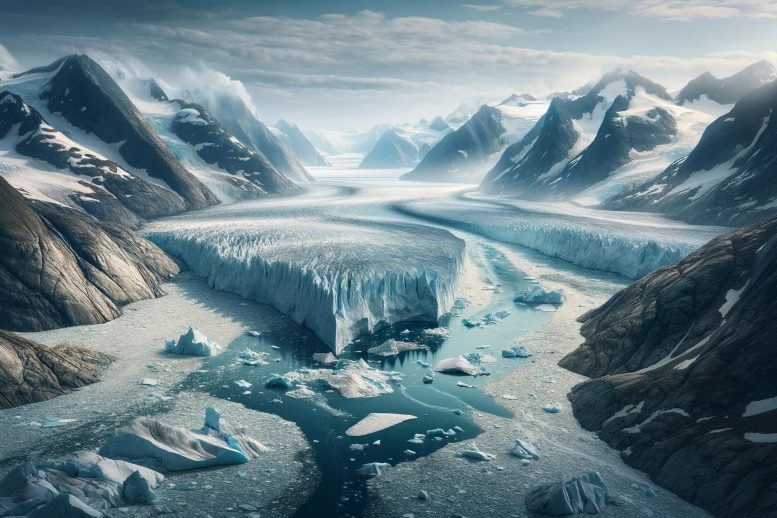
Danish researchers have conducted a comprehensive study revealing a dramatic increase in Greenland’s glacier melting over the past 20 years, five times faster than in the 80s and 90s. This study, spanning 130 years and involving 1,000 glaciers, has resolved doubts about the extent of melting due to climate change. The findings highlight the urgent need for CO2 emission reduction to slow future sea level rise.
In the largest survey of its kind ever conducted researchers from the University of Copenhagen firmly establish that Greenland’s glaciers are melting at an unprecedented pace.
In the largest survey of its kind ever conducted, using both satellite imagery and old aerial photos from the Danish National Archives, researchers from the University of Copenhagen firmly establish that Greenland’s glaciers are melting at an unprecedented pace. Melting has increased fivefold in the past 20 years. The study eliminates any lingering doubts about the impact of climate change on Greenland’s more than 20,000 glaciers.
Based on the most comprehensive monitoring of Greenland’s glaciers to date, Danish researchers have been able to cast aside any doubt regarding the impact of climate change on the planet.
Their new results document that, compared to the 80s and 90s, when glaciers shrank by an average of about five meters a year, melting has increased fivefold during the past 20 years, so that today, 25 meters per year are lost.
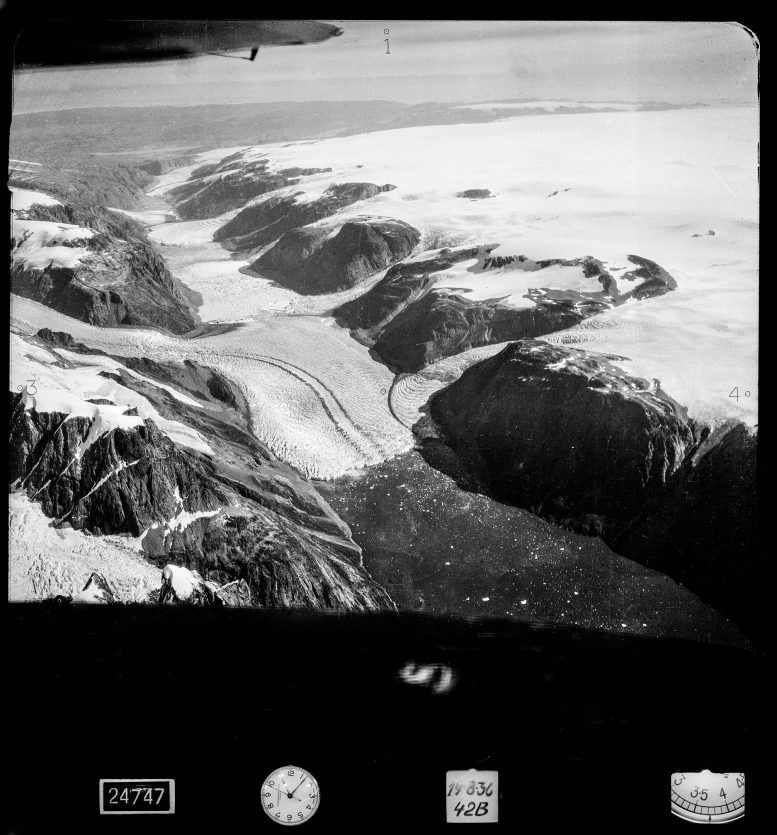
Glacier in The Ujaraannaq valley in West Greenland taken from a seaplane in 1936. Credit: The Agency for Data Supply and Infrastructure
Advancements in Glacial Research
The new study shows the response of Greenland’s glaciers to climate change over a 130-year period. The past two decades stand out in particular, as melting during this period increased even more dramatically.
The study has been published today in the scientific journal Nature Climate Change.
A number of studies in recent years have shown that Greenland’s largest glaciers are under massive pressure due to climatic changes and rising temperatures. However, doubts remained about the extent of the melting glaciers, of which there are approx. 22,000 in Greenland, partly due to inadequate measurement methods. But any doubts that may have existed before have now been dispelled by the Danish researchers.
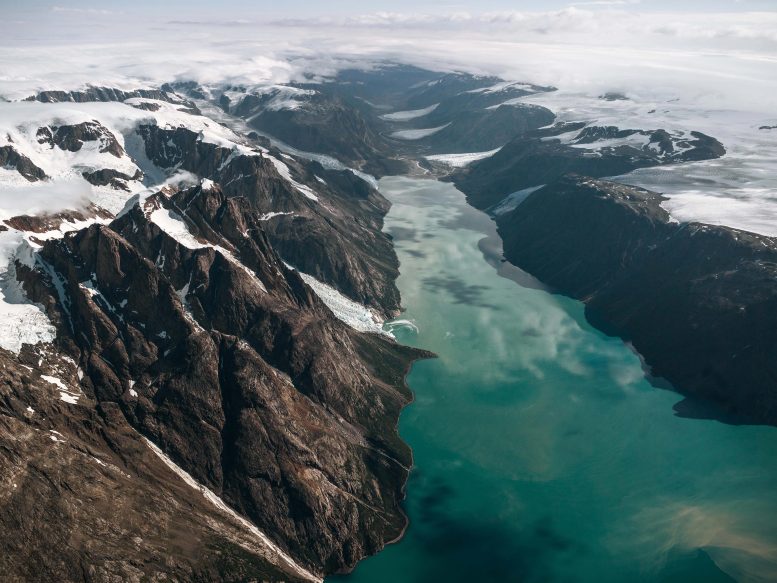
The Ujaraanaq valley in 2013, the fjord is now bare of ice and the glaciers have melted onto land. Credit: Hans Henrik Tholstrup / University of Copenhagen
“In this article, we make it clear that Greenland’s glaciers are all melting, and that things have moved exceptionally fast over the past 20 years. There is no doubt about the extent anymore and actually no reason to investigate the claim further,” says Assistant Professor Anders Bjørk from the Department of Geosciences and Natural Resource Management.
Groundbreaking Data Collection
According to the researcher, previous doubts were warranted to a certain extent. Indeed, the possibilities of investigating and documenting the extent to which glaciers melted away over extended periods of time were limited prior to the era of satellite imagery.
For example, only one of Greenland’s approximately 22,000 glaciers was continuously monitored using so-called mass balance measurements, which began in the mid-1990s. At the same time, there were areas of Greenland covered by glacier that seemed unaffected by rising temperatures just a few years back.
“Previously, we saw areas in northern Greenland, for example, that were lagging behind and melting less compared to the hardest hit glaciers. This generated a bit of doubt about how serious things were in these areas. At the same time, no one before us had ever shed light on such a long period of time, which precipitated doubts as well. But now, the picture is conclusive: The melting of all glaciers is in full swing, there is no longer any doubt,” says Anders Bjørk.
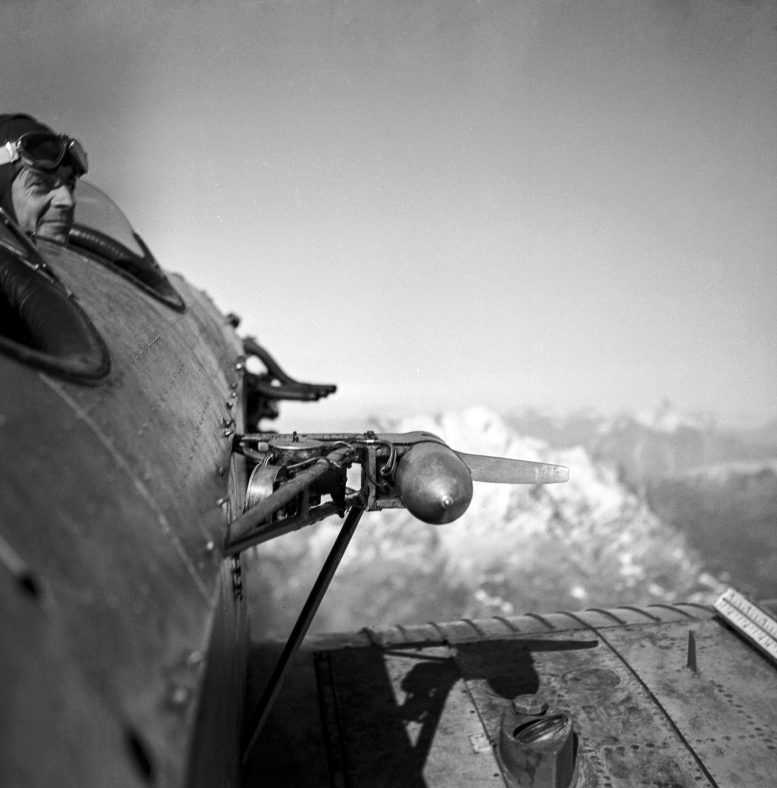
The open Heinkel seaplane made for the mapping expeditions. Credit: The danish Agency for Data Supply and Infrastructure
To gain a full overview, the researchers closely studied 1,000 of Greenland’s glaciers, a representative amount for the entire country. They tracked the melting of glaciers over the past 130 years using satellite images and 200,000 old aerial photos from the Danish National Archives, which had previously been used to make maps.
“Slightly more than 1,000 glaciers is an enormous number to study, but we did so because we simply wanted to be absolutely certain to get a comprehensive picture of developments over the last 130 years,” says Anders Bjørk.
Consequences of Melting Glaciers
While Anders Bjørk says that there is no longer much reason to look into whether glaciers are melting or not, the development still needs to be closely monitored. Over the past twenty years, melting glaciers have contributed to about 21% of observed sea level rise.
“Of course, we’ll be keeping a close eye on developments. We’re in a new era where glaciers are generally in retreat, with major consequences for sea levels that will rise faster and faster,” he says.
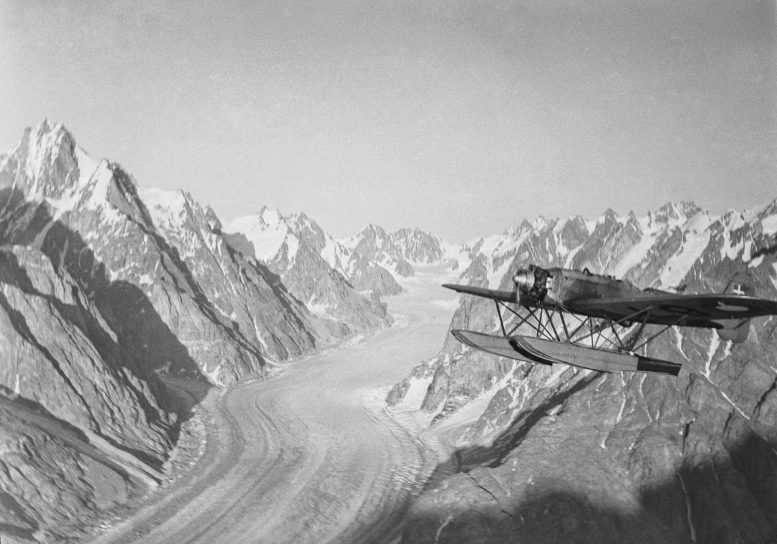
The open Heinkel seaplane over the Stauning Alps in East Greenland, 1933. Credit: The Agency for Data Supply and Infrastructure
Paradoxically, the melting of glaciers in Greenland will lead to a lack of water. Glaciers will reach a point at which they become so small that meltwater rivers will be diminished or disappear altogether. Among other things, this means that Greenland’s ecosystems will change and that renewable energy will face unforeseen hurdles:
“Today, there is already a very real problem in Greenland that the sites where hydroelectric power plants were built 15-20 years ago, based upon the melt from smaller glaciers, do not get enough water because the ice is gone and not being formed again,” says the researcher.
Perspectives on the Future
As a researcher and private person, what do you think about the extent of the melt that your study presents?
“I think it’s quite disturbing. Because we’re well aware of where this is headed in the future. Temperatures will continue to rise and glaciers will melt faster than they do now,” says Anders Bjørk, adding:
“But our study also shows that glaciers respond to climate change very quickly, which is in itself positive because it tells us that it’s not too late to minimize warming. Everything that we can do to reduce CO2 emissions now will result in slower sea level rise in the future.”
About the study
- In combination with satellite observations, the researchers used an untapped archive of aerial photos to document the development of more than 1,000 land-terminating glaciers in Greenland.
- The researchers’ observations cover all of Greenland’s major regions over a 130-year period and, for the first time ever, make it possible to document the extent of glacial retreat during the 21’ century, throughout Greenland, within the 130-year time scale.
- Over thirteen decades of observation, scientists have observed a significant and widespread retreat among Greenland’s glaciers.
- The pace at which glaciers have retreated over the past two decades has accelerated dramatically.
- Furthermore, despite the wide range of climate zones and glacier characteristics across Greenland, scientists find that this latest acceleration in retreat is ubiquitous and includes Earth’s northernmost glaciers.
- Together, these findings indicate that the rate of retreat observed in the twenty-first century is exceptional for Greenland when viewed in a century-long context.
- The study was conducted by a group of researchers from the University of Copenhagen and GEUS together with American colleagues.
- The study has been published in the scientific journal Nature Climate Change.
Reference: “Greenland-wide accelerated retreat of peripheral glaciers in the twenty-first century” by L. J. Larocca, M. Twining–Ward, Y. Axford, A. D. Schweinsberg, S. H. Larsen, A. Westergaard–Nielsen, G. Luetzenburg, J. P. Briner, K. K. Kjeldsen and A. A. Bjørk, 9 November 2023, Nature Climate Change.
DOI: 10.1038/s41558-023-01855-6









“Paradoxically, the melting of glaciers in Greenland will lead to a lack of water.”
The other side of that coin is that should the climate change the other direction, and the ice quit melting, there would still be a lack of water! Additionally, the dams would be threatened by advancing ice.
Considering that the ice has been melting for about 12,000 years, and the rise in sea level has been nearly linear for about the last 7,000 years, one should question whether 20 years of observations is sufficient to confidently imply that the future will be characterized by a similar acceleration.